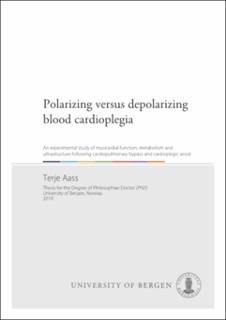| dc.contributor.author | Aass, Terje | en_US |
| dc.date.accessioned | 2019-01-24T15:41:57Z | |
| dc.date.available | 2019-01-24T15:41:57Z | |
| dc.date.issued | 2019-01-11 | |
| dc.identifier.isbn | 978-82-308-3572-2 | en_US |
| dc.identifier.uri | https://hdl.handle.net/1956/18994 | |
| dc.description.abstract | In cardiothoracic surgery, the use of the heart-lung machine for cardiopulmonary bypass (CPB) and induced cardiac arrest, cardioplegia, is required for performing the majority of the surgical procedures. Myocardial protection is essential during the ischemic period of cardioplegia. The aim of this project is to evaluate and verify if a recently developed routine for myocardial protection is feasible, safe and suited for use in clinical practice. This pre-clinical translational animal research project is designed to bridge the gap between basic research and new routines that may benefit the patient. In three different protocols, two groups of animals (10 in each group) are randomized to polarized or depolarized cardioplegic arrest. The novel and unexplored cardioplegic solution with esmolol, adenosine and magnesium; St Thomas’ Hospital polarizing cardioplegia (STH-POL) is compared with today’s gold standard; potassium-based St Thomas’ depolarizing solution (STH-2), both administered as repeated, cold, oxygenated blood. Left ventricular regional and global function in the early hours after weaning from CPB are evaluated together with myocardial ultrastructure and metabolism. Our hypothesis is that STH-POL improves myocardial protection demonstrated as better preserved postoperative cardiac function in a large animal translational model. This knowledge is essential before initiating clinical studies and implementation. An optimal myocardial protection is important when performing cardiac surgery in an ageing population with increased occurrence of more complex heart diseases and comorbidity. Paper I demonstrated improved regional and global contractility following 60 min of cardioplegic arrest with STH-POL compared to STH-2 blood cardioplegia. After weaning from CPB and following reperfusion, left ventricular dP/dtmax, Preload Recruitable Stroke Work and radial peak systolic strain rate were maintained 180 min after declamping in the group with polarized arrest and decreased with depolarized arrest. Paper II focused on energy metabolism and ultrastructure with the STH-POL compared to the STH-2 cardioplegia during 60 min of cardiac arrest and at early reperfusion. The study demonstrated increased levels of creatine phosphate in left ventricular myocardial tissue samples at the end of the period of cardioplegic arrest and early after reperfusion in the STH-POL compared to the STH-2 group. Furthermore, the adenosine triphosphate content was increased and the mitochondrial surface-to-volume ratio decreased with polarizing compared to depolarizing cardioplegia 20 min after reperfusion. However, at 180 min after reperfusion these group differences were negligible. Paper III addressed myocardial function after prolonged cardioplegic arrest for 120 min. A temporary increase in the load-independent contractility variable Preload Recruitable Stroke Work was seen in the STH-POL compared to the STH-2 group 150 min after declamping. Neither regional nor global left ventricular function differed between groups up to 240 min after declamping. However, compared to the STH-2 group, the left ventricular myocardial tissue blood flow rate decreased in the STHPOL group at 150 and 240 min compared to 60 min after declamping. The relationship between the left ventricular total pressure-volume area and blood flow rate was maintained after declamping in the STH-POL group and decreased in the STH-2 group. Thus, cardioplegic arrest with STH-POL alleviated the mismatch between myocardial function and perfusion after weaning from CPB compared to STH-2. Conclusion: In a porcine model, cardioplegic arrest with St. Thomas´ Hospital polarizing solution offered comparable myocardial protection and improved myocardial function (Paper I), preserved energy status (Paper II) and enhanced contractile efficiency (Paper III) in the early hours after weaning from cardiopulmonary bypass compared to St. Thomas´ Hospital No 2 blood cardioplegia. | en_US |
| dc.language.iso | eng | eng |
| dc.publisher | The University of Bergen | eng |
| dc.relation.haspart | Paper I: Aass T, Stangeland L, Moen CA, Salminen PR, Dahle GO, Chambers DJ, Markou T, Eliassen F, Urban M, Haaverstad R, Matre K, Grong K. Myocardial function after polarizing versus depolarizing cardiac arrest with blood cardioplegia in a porcine model of cardiopulmonary bypass. Eur J Cardiothorac Surg 2016; 50:130-139. <a href=" https://doi.org/10.1093/ejcts/ezv488" target="blank"> https://doi.org/10.1093/ejcts/ezv488</a> | en_US |
| dc.relation.haspart | Paper II: Aass T, Stangeland L, Chambers DJ, Hallström S, Rossmann C, Podesser BK, Urban M, Nesheim K, Haaverstad R, Matre K, Grong K. Myocardial energy metabolism and ultrastructure with polarizing and depolarizing cardioplegia in a porcine model. Eur J Cardiothorac Surg 2017; 52:180-188. <a href="https://doi.org/10.1093/ejcts/ezx035" target="blank">https://doi.org/10.1093/ejcts/ezx035</a> | en_US |
| dc.relation.haspart | Paper III: Aass T, Stangeland L, Solholm A, Moen CA, Dahle GO, Chambers DJ, Urban M, Nesheim K, Haaverstad R, Matre K, Grong K. Left ventricular dysfunction after two hours of polarizing or depolarizing cardioplegic arrest in a porcine model. Perfusion 2019; 34:67-75. <a href="https://doi.org/10.1177/0267659118791357" target="blank">https://doi.org/10.1177/0267659118791357</a> | en_US |
| dc.title | Polarizing versus depolarizing blood cardioplegia: An experimental study of myocardial function, metabolism and ultrastructure following cardiopulmonary bypass and cardioplegic arrest | en_US |
| dc.type | Doctoral thesis | |
| dc.rights.holder | Copyright the author. All rights reserved. | |
| dc.subject.nsi | VDP::Medisinske Fag: 700::Klinisk medisinske fag: 750 | en_US |
